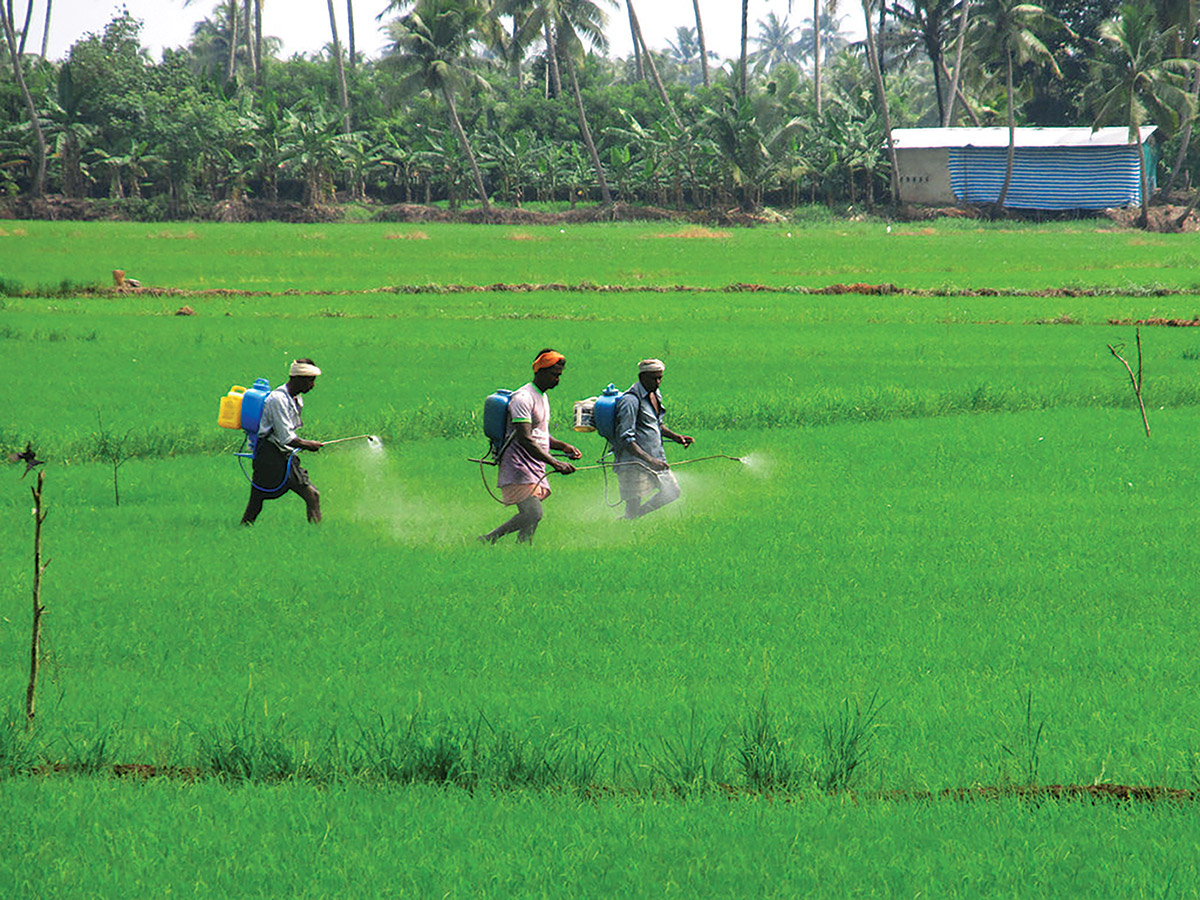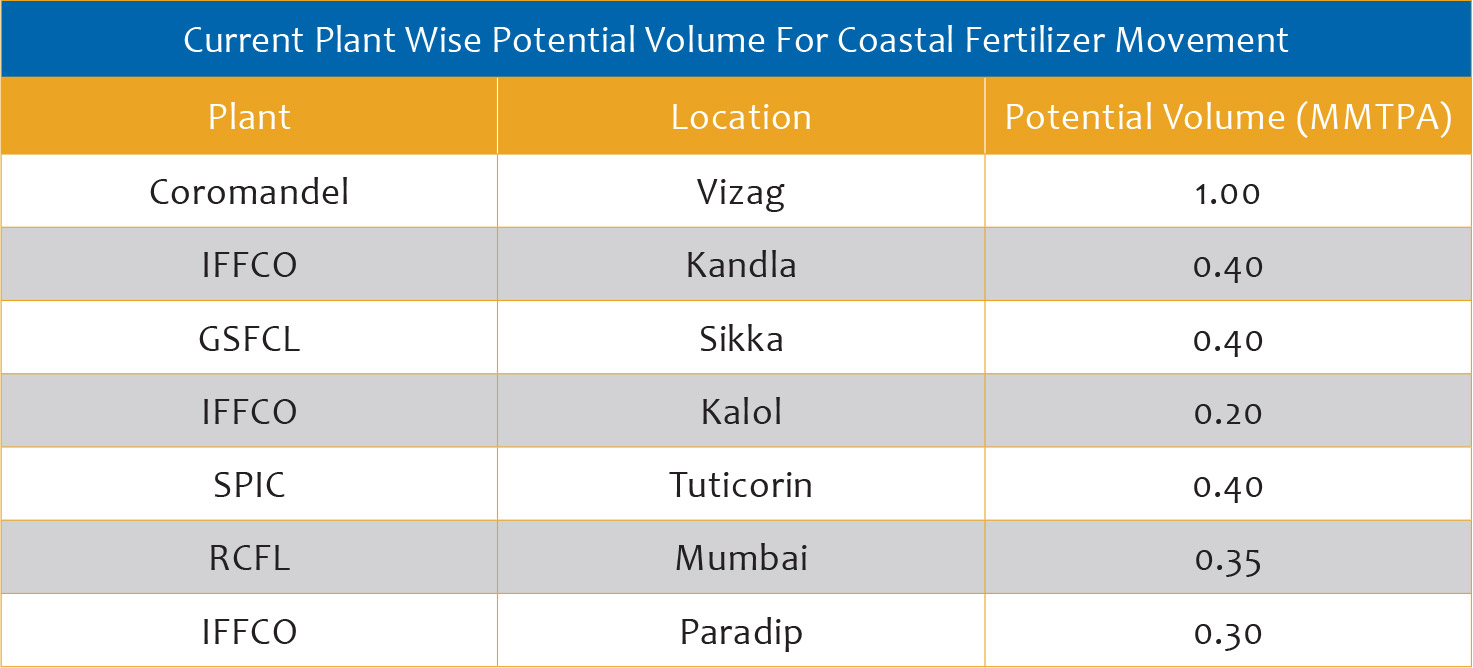Fertilizers are the backbones for agricultural productivity. The demand for fertilizer has grown along with the demand for food. In the last five years, the consumption of fertilizers has increased by around 2.5 per cent and is expected to rise to approximately 4 per cent in the future. Growing agricultural produce with an increase in the overall sown area will prompt greater demand for fertilizer end products-around 70 MMTPA by 2020 and around 120 MMTPA by 2035.
The commodity contributes about 2 per cent of the total cargo handled at Indian Ports. Currently, India imports 28 MMT of finished fertilizers and raw materials with Andhra Pradesh, Gujarat and Odisha being the biggest clusters. Kakinada, Mundra and Kandla continue to be the largest finishedfertilizer importing ports, while Paradip, Kandla and Vishakhapatnam are the largest fertilizer raw material importing ports. It is estimated that the volume of imports of fertilizer raw materials and finished products will grow at around 4 per cent, keeping the volumes handled at Indian ports fairly stable until 2020.
Price Control Mechanism
Fertilizers declared under the essential commodity act have been regulated by the Department of Fertilizers through Fertilizer Control Act. The act aims at making fertilizers available to all the farmers by controlling the prices and distribution to all states.
Urea is the most consumed fertilizer hence is closely regulated and directly subsidized. Maximum retail prices of Urea is fixed by the Department of Fertilizers, whereas prices of DAP, MOP and other complex fertilizers is derived from the demand and supply.

Movement Control Mechanism
Fertilizer availability to the farmers is monitored using a Fertilizer Monitoring System based on which the demand is estimated and met through domestic production and imports. Movement of Urea is fully regulated whereas movement of DAP, MOP and other complex fertilizers are partially controlled. The manufacturer/supplier is reimbursed for the movement cost over and above the production cost subsidy based on the policy of Nutrient Based Subsidy (NBS).
Currently, rail is preferred as the primary mode of transport for longdistance fertilizer movement. The freight for direct rail movement from plant or port (primary movement) is subject to lower of actual claim and equivalent rail freight up to a maximum distance of 1400 Kms. The freight for direct road movement from plant or port (primary movement) is subject to lower of actual claim and equivalent freight up to a maximum distance of 500 Kms.
However, the secondary freight is paid only in-line with the maximum road movement limit as per the Uniform Freight Subsidy.
Coastal Shipping – Fertilizer Movement
Coastal shipping and inland waterways currently form around 7 per cent of the total modal mix in India, compared to around 10–20 per cent for other emerging countries like China. To promote transportation of fertilizers through coastal shipping under the Ministry of Shipping’s flagship programme ‘Sagarmala’, the freight subsidy, which was earlier only applicable to the movement of fertilizer by rail from the plant or port to various rake points in various districts, will now also apply to the primary movement of fertilizers through coastal shipping and inland waterways but at the lower of the equivalent railway rates or actual freight paid.
The study conducted as part of the Sagarmala programme identified that the total opportunity for coastal movement of fertilisers is 6-7 MTPA by 2025, with an estimated savings of around 900 Crore to 1,000 Crore per annum.
Coastal fertilizer plants in Andhra Pradesh, Gujarat and Odisha have the potential to ship their products to the peninsular states via coastal routes. If the key rail movements are considered from the major fertilizer plants to the top-200 fertilizer-consuming districts in the country, around 7 plants have the highest potential to shift to coastal shipping.
Cabotage Relaxation - Coastal Shipping
In a move aimed at further removing the bottlenecks at transporting fertilisers, the government has done away with the licensing permits for foreign vessels to transport fertilizers. As per the earlier regulatory framework, a foreign ship can load cargo from one port in India and discharge at any other port in the country only under a licence issued by the Director General of Shipping.
Now, a foreign vessel is not required to obtain a licence from the Director General of Shipping for engaging in the carriage of fertilizers via sea route. The relaxation is subject to conditions like the quantity of fertilisers should contribute to at least 50 per cent of the total cargo onboard the ship.
Movement Types - Coastal Shipping
Break-Bulk
The bagged cargo is pre-slung at load port and is loaded directly into the vessel holds and transported via coastal route to various disport locations using Mini-Bulk Carriers (MBCs) or covered sea barges. At disport location the pre-slung cargo inside the hold is directly hooked onto the cranes and offloaded at the wharf as against the usage of net slings, thus avoiding the additional cost and time using more labour.
Containers
Containerization of bagged cargo is also very attractive for coastal movement as it ensures movement of cargo in a much safer way by reducing multiple handling of bags in the whole operation as against break-bulk. The handling losses are very negligible and ensure the quality of the final product delivered.
Also, with the relaxation of the cabotage law foreign vessels will now be able to carry boxes to various domestic ports by providing competitive rates on ocean freight thus bringing down the overall logistics expenditure.

- Benefits - Shifting to Coastal Shipping
- Decongesting the already overburdened rail and road network
- Timely clearance of cargo from the ports without relying on rake availability
- Less carbon footprint by reducing the greenhouse emissions on per tonne-km of transportation for longer distances
- Helps in significantly cutting down the per tonne-km cost for transporting fertilizer at longer distances
- Way Forward - Growth of Coastal Shipping
- Creating dedicated coastal berths and infrastructure facilities at the relevant ports
- Dedicated container liner services and CFS to be established at the important ports along the coastal route identified for fertilizer traffic
- Setting up storage capacities at origin-destination ports for safe receipt and storage
- Ensuring two-way cargo movement, which has the potential of reducing the cost of coastal transport, hence improving cargo volumes and facilitating investment in fleets
- Availability of adequate number of small-sized, good condition, river-seaworthy vessels
- Reliability of service, frequency and a comprehensive multimodal logistics solution will ensure the shift from the conventional modes of transport to coastal shipping